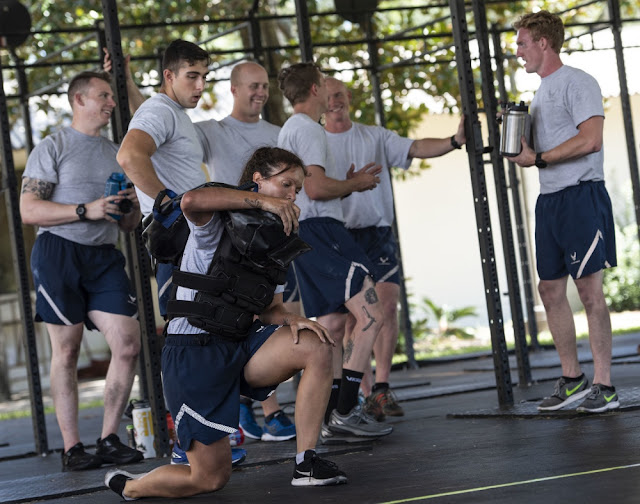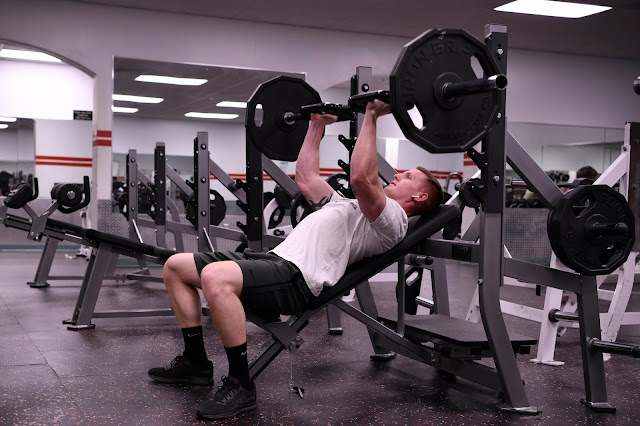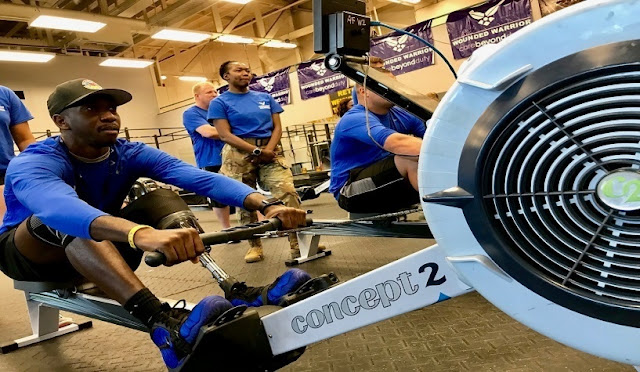EOD test prototype of new job-specific fitness test

Story by Ilka Cole
Eglin Air Force Base
During a deluge of rain, 21 explosive ordnance disposal technicians from seven bases across the Air Force ran a mile and a half to the gym and completed a timed 1,000-meter row.
That was just the beginning of their 36-hour fitness test and assessment.
The 96th Civil Engineer Group’s EOD flight recently hosted and participated in the beta test for the Air Force’s prototype of the new EOD ‘Tier 2’ physical fitness test based on job demands Sept. 10 – 12, 2018.
“Working in very close coordination with EOD technicians, we developed the test components and standards from EOD-specific physical requirements and the tasks they perform on operational missions,” said Dr. Neal Baumgartner, Air Force Exercise Science Unit chief.
The new physical standards and acclimation period are scheduled to go into effect in 2019 and are tailored to ensure EOD Airmen are fit to accomplish the strenuous demands of their mission.
“This will be the new standard for anyone who wants to be an EOD operator regardless of age and gender,” said Capt. Cory McCart, EOD flight commander for the 96th CEG.
The Air Force began the rollout of Tier 2 physical training standards earlier this year at Andrews Air Force Base, Maryland.
At Eglin EOD Airmen were tested, and individual performance results for each exercise were documented to establish a baseline for fitness and strength.
As part of the baseline testing they donned 30-pound vests to perform what they nicknamed the ‘Gruester,’ a strenuous combination of a push-up, planks, a rollover with a 50-pound sandbag and an over-the-shoulder carry with the sandbag for a 15-meter run for 20 rounds. The total load carry was 80 pounds. A15-meter run without the 50-pound sandbag was also performed between rounds.
“The ‘Gruester’ was brutal,” said Tech. Sgt. Cole Carroll-Grandegenett, who is assigned to the 52nd CES at Spangdahlem Air Base in Germany. “It is my understanding the ESU found those who performed it at a high level also performed EOD operations at a high level. They can conserve their energy longer and have the endurance to keep pushing.”
After the Tier 2 physical training test Airmen ruck marched for an hour to reach the EOD training complex where they executed the overnight operational phase. The 30-hour phase was planned and executed by 96th CES EOD flight members.
“Airmen ran through the gamut of primary missions, which included airfield and range clearance and chemical operations,” said Tech Sgt. Ryan Hoagland, organizer of the operations phase and 96th CES EOD flight member. “They also encountered improvised explosive scenarios similar to those they may encounter in Afghanistan or at home station.”
The Air Force’s prototype PF test was designed to show the physical abilities needed for some of the more grueling career fields to establish if an Airman is physically well-matched.
“The test is so specific – if we excel at it, we’ll be more physically fit, be better EOD techs and perform the mission more efficiently,” said Staff Sgt. Ashley Banta, 48th CES team leader from Royal Air Force Lakenheath, England.
Following the 30 hours of continuous EOD operations, the Airmen completed the PF test a second time.
“The purpose of the ESU’s evaluation of this phase is to help adjust performance standards based on actual mission and environmental impacts,” said Chief Master Sgt. Alex Morgan III, 96th CEG superintendent.
The new test components and standards were developed by the Air Force’s ESU at Joint Base San Antonio after several years of research, feedback and input from the EOD career field.
The Tier 2 EOD Prototype PF Test Battery consists of the following exercises:
- 1.5 mile run
- 1000 meter row
- 20-lb. medicine ball toss, overhead and sideways
- Grip strength
- Trap bar deadlift with maximum weight capable for five repetitions
- 3-inch square bar static hold for maximum time (61 pounds)
- Pull-ups
- Cross knee crunches to metronome (56 beats per minute) until failure
- Farmer’s carry with two 50-pound sandbags (one in each hand) for 100 meters
- Gruester
“We were selected to conduct this test for our high-heat and humidity location, our robust training infrastructure and our capability to run multiple mission scenarios simultaneously,” said Morgan. “This was demonstrated in 2017 and earlier this year with the EOD Warfighter Challenge, when we trained more than 90 operators from every MAJCOM in 10 days.”
The Eglin EOD flight was one of two units selected to plan, organize and execute this key validation component. The other unit was Ellsworth AFB in South Dakota, to study environmental stressors and impacts on performance at varying elevations, said Morgan.
That was just the beginning of their 36-hour fitness test and assessment.
The 96th Civil Engineer Group’s EOD flight recently hosted and participated in the beta test for the Air Force’s prototype of the new EOD ‘Tier 2’ physical fitness test based on job demands Sept. 10 – 12, 2018.
“Working in very close coordination with EOD technicians, we developed the test components and standards from EOD-specific physical requirements and the tasks they perform on operational missions,” said Dr. Neal Baumgartner, Air Force Exercise Science Unit chief.
The new physical standards and acclimation period are scheduled to go into effect in 2019 and are tailored to ensure EOD Airmen are fit to accomplish the strenuous demands of their mission.
“This will be the new standard for anyone who wants to be an EOD operator regardless of age and gender,” said Capt. Cory McCart, EOD flight commander for the 96th CEG.
The Air Force began the rollout of Tier 2 physical training standards earlier this year at Andrews Air Force Base, Maryland.
At Eglin EOD Airmen were tested, and individual performance results for each exercise were documented to establish a baseline for fitness and strength.
As part of the baseline testing they donned 30-pound vests to perform what they nicknamed the ‘Gruester,’ a strenuous combination of a push-up, planks, a rollover with a 50-pound sandbag and an over-the-shoulder carry with the sandbag for a 15-meter run for 20 rounds. The total load carry was 80 pounds. A15-meter run without the 50-pound sandbag was also performed between rounds.
“The ‘Gruester’ was brutal,” said Tech. Sgt. Cole Carroll-Grandegenett, who is assigned to the 52nd CES at Spangdahlem Air Base in Germany. “It is my understanding the ESU found those who performed it at a high level also performed EOD operations at a high level. They can conserve their energy longer and have the endurance to keep pushing.”
After the Tier 2 physical training test Airmen ruck marched for an hour to reach the EOD training complex where they executed the overnight operational phase. The 30-hour phase was planned and executed by 96th CES EOD flight members.
“Airmen ran through the gamut of primary missions, which included airfield and range clearance and chemical operations,” said Tech Sgt. Ryan Hoagland, organizer of the operations phase and 96th CES EOD flight member. “They also encountered improvised explosive scenarios similar to those they may encounter in Afghanistan or at home station.”
The Air Force’s prototype PF test was designed to show the physical abilities needed for some of the more grueling career fields to establish if an Airman is physically well-matched.
“The test is so specific – if we excel at it, we’ll be more physically fit, be better EOD techs and perform the mission more efficiently,” said Staff Sgt. Ashley Banta, 48th CES team leader from Royal Air Force Lakenheath, England.
Following the 30 hours of continuous EOD operations, the Airmen completed the PF test a second time.
“The purpose of the ESU’s evaluation of this phase is to help adjust performance standards based on actual mission and environmental impacts,” said Chief Master Sgt. Alex Morgan III, 96th CEG superintendent.
The new test components and standards were developed by the Air Force’s ESU at Joint Base San Antonio after several years of research, feedback and input from the EOD career field.
The Tier 2 EOD Prototype PF Test Battery consists of the following exercises:
- 1.5 mile run
- 1000 meter row
- 20-lb. medicine ball toss, overhead and sideways
- Grip strength
- Trap bar deadlift with maximum weight capable for five repetitions
- 3-inch square bar static hold for maximum time (61 pounds)
- Pull-ups
- Cross knee crunches to metronome (56 beats per minute) until failure
- Farmer’s carry with two 50-pound sandbags (one in each hand) for 100 meters
- Gruester
“We were selected to conduct this test for our high-heat and humidity location, our robust training infrastructure and our capability to run multiple mission scenarios simultaneously,” said Morgan. “This was demonstrated in 2017 and earlier this year with the EOD Warfighter Challenge, when we trained more than 90 operators from every MAJCOM in 10 days.”
The Eglin EOD flight was one of two units selected to plan, organize and execute this key validation component. The other unit was Ellsworth AFB in South Dakota, to study environmental stressors and impacts on performance at varying elevations, said Morgan.



Comments
Post a Comment